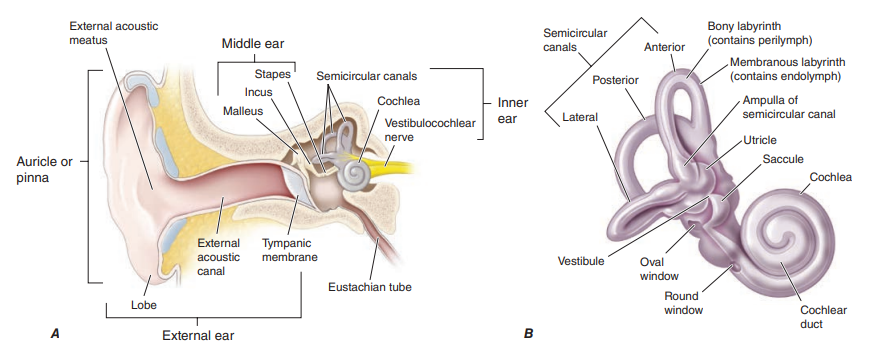Makindo Medical Notes"One small step for man, one large step for Makindo" |
|
|---|---|
| Download all this content in the Apps now Android App and Apple iPhone/Pad App | |
| MEDICAL DISCLAIMER: The contents are under continuing development and improvements and despite all efforts may contain errors of omission or fact. This is not to be used for the assessment, diagnosis, or management of patients. It should not be regarded as medical advice by healthcare workers or laypeople. It is for educational purposes only. Please adhere to your local protocols. Use the BNF for drug information. If you are unwell please seek urgent healthcare advice. If you do not accept this then please do not use the website. Makindo Ltd. |
Anatomy of the Ear
-
| About | Anaesthetics and Critical Care | Anatomy | Biochemistry | Cardiology | Clinical Cases | CompSci | Crib | Dermatology | Differentials | Drugs | ENT | Electrocardiogram | Embryology | Emergency Medicine | Endocrinology | Ethics | Foundation Doctors | Gastroenterology | General Information | General Practice | Genetics | Geriatric Medicine | Guidelines | Haematology | Hepatology | Immunology | Infectious Diseases | Infographic | Investigations | Lists | Microbiology | Miscellaneous | Nephrology | Neuroanatomy | Neurology | Nutrition | OSCE | Obstetrics Gynaecology | Oncology | Ophthalmology | Oral Medicine and Dentistry | Paediatrics | Palliative | Pathology | Pharmacology | Physiology | Procedures | Psychiatry | Radiology | Respiratory | Resuscitation | Rheumatology | Statistics and Research | Stroke | Surgery | Toxicology | Trauma and Orthopaedics | Twitter | Urology
Related Subjects: |Anatomy of the Ear |Anatomy of the Oesophagus |Anatomy of the Diaphragm |Anatomy of Large Bowel |Anatomy of Small Bowel |Anatomy of the Biliary system |Anatomy of the Eye |Anatomy of the Larynx |Anatomy of the Ear
👂 Anatomy of the Ear
The ear is a complex organ responsible for hearing 🎧 and balance ⚖️. It is divided into three major sections: the external ear, middle ear, and inner ear. Each section has a unique role in sound conduction and equilibrium.

📌 External Ear
Includes the auricle (pinna) and the external auditory canal, ending at the tympanic membrane.
- Auricle (Pinna):
- Cartilage covered by skin, shaped to funnel sound waves inward.
- Landmarks: helix, antihelix, tragus, antitragus, concha, lobule.
- Clinical Pearl: Auricular haematoma (from trauma) can cause “cauliflower ear” if untreated.
- External Auditory Canal:
- ~2.5 cm long, lined with ceruminous glands producing cerumen (earwax).
- Protects against dust, insects, and microbial growth.
- Clinical Pearl: Otitis externa (“swimmer’s ear”) causes painful, inflamed canal.
- Tympanic Membrane (Eardrum):
- Thin, cone-shaped membrane vibrating with sound waves.
- Transfers vibrations to ossicles in the middle ear.
- Clinical Pearl: Perforated eardrum ➝ conductive hearing loss.
📌 Middle Ear
An air-filled cavity containing the ossicles and the Eustachian tube.
- Ossicles (Malleus, Incus, Stapes):
- Malleus (“hammer”) attached to tympanic membrane.
- Incus (“anvil”) bridges malleus and stapes.
- Stapes (“stirrup”) attached to oval window ➝ sends vibrations into inner ear fluid.
- Clinical Pearl: Otosclerosis (abnormal stapes fixation) causes progressive conductive hearing loss.
- Eustachian Tube:
- Connects middle ear ➝ nasopharynx.
- Equalizes pressure (opens on swallowing/yawning).
- Clinical Pearl: Blocked tube (e.g., after URTI) ➝ otitis media with effusion (“glue ear”).
📌 Inner Ear
Also called the labyrinth. Contains the cochlea (hearing) and vestibular system (balance). Filled with endolymph and perilymph.
- Cochlea:
- Spiral structure containing the organ of Corti (sensory hair cells).
- Converts mechanical vibrations ➝ electrical signals transmitted via cochlear nerve.
- Clinical Pearl: Noise-induced hearing loss damages high-frequency hair cells first.
- Vestibular System:
- Semicircular Canals: Detect rotational movement (angular acceleration).
- Utricle & Saccule: Detect linear acceleration and gravity via otoliths (calcium carbonate crystals).
- Clinical Pearl: Dislodged otoliths ➝ benign paroxysmal positional vertigo (BPPV).
🧠 Nerve Supply of the Ear
- Cochlear Nerve (CN VIII): Hearing.
- Vestibular Nerve (CN VIII): Balance & spatial orientation.
- Facial Nerve (CN VII): Passes through middle ear; gives chorda tympani branch (taste anterior 2/3 tongue).
- Glossopharyngeal Nerve (CN IX): Sensory to middle ear & Eustachian tube.
- Clinical Pearl: Acoustic neuroma (vestibular schwannoma) ➝ hearing loss, tinnitus, imbalance, facial weakness.
🫀 Vascular Supply
- External Ear: Posterior auricular & superficial temporal arteries.
- Middle Ear: Anterior tympanic (maxillary) & ascending pharyngeal arteries.
- Inner Ear: Labyrinthine artery (branch of AICA or basilar artery).
- Clinical Pearl: Inner ear ischemia ➝ sudden sensorineural hearing loss.
⚡ Functions of the Ear
- Hearing 🎶: Converts sound waves ➝ neural signals ➝ auditory cortex.
- Balance ⚖️: Vestibular system detects movement & orientation, integrated with vision & proprioception.
- Pressure Regulation: Eustachian tube maintains equal air pressure across tympanic membrane.